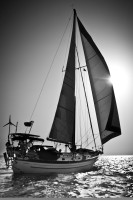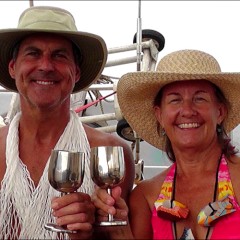
Slow Sailing
25 February 2020
29 November 2019 | Vero Beach
09 October 2019 | Washington, NC
27 September 2019
06 September 2019 | Norfolk, VA
07 August 2019 | Washington, NC
07 July 2019 | Washington
10 June 2019 | Washington, NC
15 May 2019 | St Augustine
30 April 2019 | Black Point, Exuma
16 April 2019 | Bahamas
02 April 2019 | Washington, NC
15 March 2019 | Washington, NC
10 February 2019 | Washington, NC
22 January 2019 | Washington, NC
07 January 2019 | Washington, NC
15 December 2018 | Washington, NC
03 November 2018 | Thetford, VT
21 September 2018 | Bradford, VT
13 August 2018 | Thetford, VT
Half Moon Cay
05 March 2008 | Purple Space Monkey Bar
Heather
Most people's blogs seem to follow a regular pattern of entries every few days but I can see that ours is quite the opposite! Ours is a bunch of info all at once, often going backwards in time (such as this one is going to be) and then nothing for weeks while we're out making more memories! Oh well, I figured I would describe our visit to Half Moon Cay in Belize and was too tired to do it last night.
The picturesque small island named Half Moon Cay is what put Belize on the map as far as tourism goes, at least for the atolls. It's also pictured on the front cover of our cruising guide, and I'd look at it whenever I was starting to lose focus on this trip while living in Boston! Sitting just inside the Southern rim of Lighthouse Reef, it's about half pure white sand and palm trees amidst varying shades of brilliant turquoise water, and half lush, bright green foliage with HUNDREDS of pairs of nesting frigate birds and red footed boobies this time of year. Right off the Southern tip of the island is the famous drop off with spectacular diving and all of this is part of the Belize Audubon Park. Seven miles North is the Blue Hole where the stunning aerial photos that Belize is famous for are taken. That too is park.
Rich & Jan accompanied us to the island and we anchored right next to each other in front of the cay. The roar of the waves hitting the outside of the barrier reef was unnerving but kind of cool. Over the hours we were there, the boat got a nice fresh coat of fine salt spray from the moisture in the air from the waves- ugh! You can climb the rusty steel lighthouse to get a really great view of the island and surrounding reef and the colors are quite stunning with the browns of the reef, yellows of sand, turquoise water and green palms. There are a few park staff who live on the island, 2 weeks on and then 1 week off. Talk about solitude....
The most exciting part for me was walking the trail to the opposite half of the island which winds through cool, tall woods and then up to the observation platform where you find yourself in the middle of a massive mating and nesting frenzy.
We also dove the reef twice since it was THE BEST dive we've ever done. Mainly because of the bottom characteristics and amount of life on the reef. It was really rough on the water and we were nauseous getting our gear on in the bucking dinghy but once we slid in, all that faded. The bottom was bright white sand filled with fish, then you swam toward the drop off but instead of the usual cliff like drop, the reef actually went upward first so there were all these beautiful coral formations complete with tunnels to swim through to the wall. Jon loves tunnels! We got the best view of an octopus ever. Jan spotted it hopping from one coral head to another and we all just watched it change color as it moved along. The water clarity was stunning and since there's no spearfishing in the park, there were large fish all over including grouper, hogfish, tarpon, jacks and king mackerel. For me, having the white sand on one side of the reef adds a neat perspective to the dive and when you have to head up to shallower water toward the end of a dive, I love to actually stand on the sand in my fins and just look around. That's the only time you can really "land" or touch anything since usually, the bottom or wall is a thick carpet of sealife that you'd harm if you touched.
The Blue Hole is over 400 feet deep and is a sunken cave. There actually isn't much for fish or reef structure there at all, but once you get below 100 feet, there are stalactite and stalagmite formations to see. From what we'd heard, the Blue Hole is best appreciated from the air and that diving it was mainly just to be able to say you'd done it but we were still intrigued. On our second visit to Half Moon, we motored up to it, dodging numerous coral patches which kept me up on the bow for an hour in the blazing sun to keep a good watch. Plus the wind was honking that day. When we got up to it, we weren't too impressed and with the wind blowing so hard, the water wasn't very clear. I mean, the concept is really neat, but given that our dive compressor was broken and we only had one scuba dive we could do- either the Blue Hole or a second dive at Half Moon, we decided we weren't doing the Blue Hole! We dinghyed around it, through it, ate lunch next to it and then motored back to Half Moon anchorage before the sun got too low. Hope we don't live to regret it!
I was really pleased with the pictures I got of the birds and some of the underwater ones are OK too. We definitely see where we have improvement to make in our photography but we both think we're taking better pictures than previous trips. We fully intend to return to this spot again since we can't seem to get enough of it. Maybe, just maybe, we'll see a whale shark one of these days.
Today we just scoped out the town of Placencia some more. Took a nice walk along the long beach that's here and got a good ol' American cheeseburger (well, sort of) at the Purple Space Monkey Cafe while we caught up on out internet stuff. We met up with some other cruisers and compared notes and I made 15 bean soup for dinner early in the day so we wouldn't heat up the cabin during the evening. The heat is really picking up with the sun feeling stronger every day. We both jumped in the water this evening to cool off. People are raving to us about the Rio Dulce, where we plan to keep Evergreen for the summer. It's a river so there's FRESH WATER!! No more salty boat for a few months. I also plan to make an air conditioner a top priority and I don't think I'll get too much resistance from Jon either!
Comments
| Vessel Name: | EVERGREEN |
| Vessel Make/Model: | Tashiba 40 Hull #158 |
| Hailing Port: | E. Thetford Vermont |
| Crew: | Heather and Jon Turgeon |
| Extra: |
Gallery not available
Profile for Evergreen and crew

Who: Heather and Jon Turgeon
Port: E. Thetford Vermont


